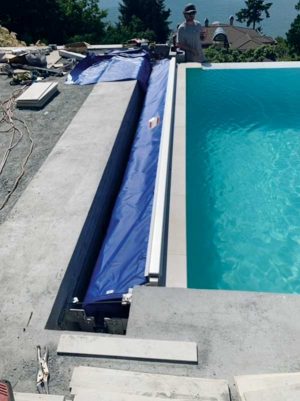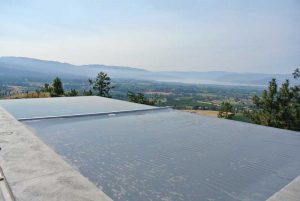
Completing automatic cover installations on vanishing-edge pools has become an everyday job for Moss and his team. To eliminate any problems, they make sure the design is well-planned.
“We know how important it is to hide the auto-cover track because seeing it really affects the esthetics of a vanishing-edge pool,” says Moss. “We can walk builders through the importance of angling the wall in or out of the pool, along with the offset beyond the vanishing edge, to keep the cover system functional and completely hidden.”
According to Moss, the key is planning the automatic cover design before starting construction on the pool.
“We work closely with builders to explain how a few minor changes will ensure the installation goes smoothly so the customer gets the most esthetically pleasing cover installation,” says Moss. “It’s very important to be able to take into consideration everything from the coping to the slope of the walls.”
The collaborative planning between the auto-cover installer and the builder is key to ensuring the successful installation of the pool cover. Not only for esthetics, but also for functionality and to make the pool safe.

Another big requirement from pool owners in Moss’ market is they want the cover to completely disappear when the auto cover is open.
“This custom feature has become commonplace in our region,” he says. “So not only will the cover need to be completely hidden in the vault, but the lead-edge bar (i.e. the bar at the front of the automatic cover that draws it out of the vault where the mechanism is housed) also must be hidden.
To do this, there are several specific considerations and adjustments swimming pool builders need to make to be able to achieve this type of installation.
“For example, on pools more than 4.6 m (15 ft) wide, you need 127 mm (5 in.) of space from the cover to the waterline for the leading edge to travel under the walk-on lid of the cover housing.
“Further, pools less than 4.6 m wide need to have 76 mm (3 in.) of space between the coping and the waterline. This means the builder will need to lower the placement of the skimmers, benches, and the spa height,” says Moss.
Unlike typical automatic cover installations, in which the vault for the cover and mechanism are placed under a standard aluminum lid, pools in the area where Moss works rarely use an aluminum lid, but always have custom, walk-on lids that match the deck. This has a lot to do with the pool construction type—as this region does not install many vinyl-liner or fibreglass pools. Instead, they are primarily gunite pools which often use new, trendy finishing materials, too.
“In our market, we are also constantly working around delicate tile and even the use of porcelain as coping,” says Moss. “If a pool uses these materials, we can’t screw the track into the coping, so we need to come up with other systems during the installation of the cover.”
Therefore, Moss says it is important for them to educate their builder partners on all the different options they need to offer their customer when it comes to an automatic pool cover.
“Our builder partners have become much more confident about bringing up all the options for auto covers and taking the necessary steps to meet customer expectations,” says Moss. “Since the auto cover is the final addition on the pool, it needs to meet or exceed customer expectations. We want our builder partners to finish the job, with the automatic cover, so they can always get the referral from their client for the next job.”
The ultimate challenge with all this customization is to install an automatic pool cover that is functional, reliable, and safe. These installation experts love the challenge and go to extremes to make automatic covers integrate beautifully to give pool owners the convenience and safety, without detracting from the gorgeous pool esthetic.
Author
 Mike Shadoan has more than 25 years of experience working as a service tech in the field. In 2013, he worked his way into the position of vice-president of sales for Automatic Pool Covers in Westfield, Ind. Shadoan has been an integral part of the company’s rapid growth. He can be reached via email at mshadoan@apc-mfg.com.
Mike Shadoan has more than 25 years of experience working as a service tech in the field. In 2013, he worked his way into the position of vice-president of sales for Automatic Pool Covers in Westfield, Ind. Shadoan has been an integral part of the company’s rapid growth. He can be reached via email at mshadoan@apc-mfg.com.






